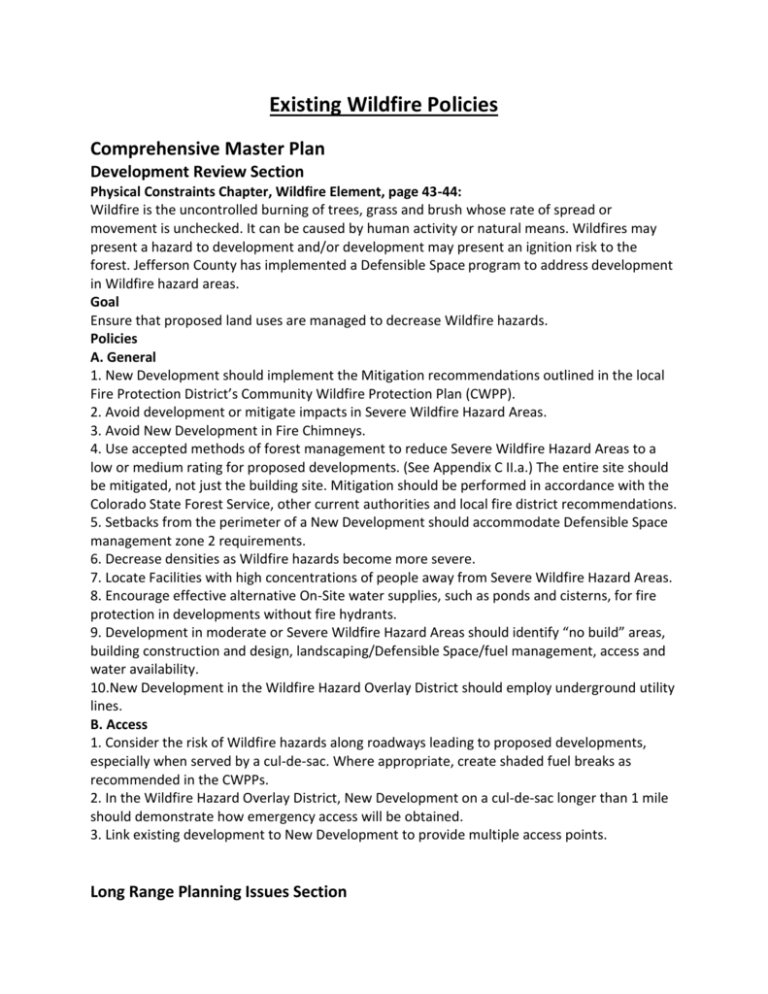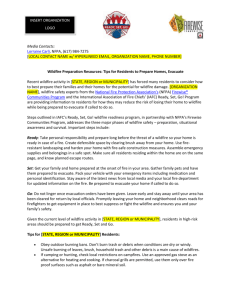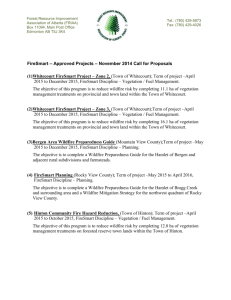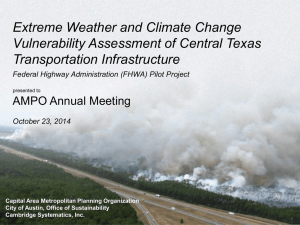Existing Wildfire Policies CMP and Conifer
advertisement

Existing Wildfire Policies Comprehensive Master Plan Development Review Section Physical Constraints Chapter, Wildfire Element, page 43-44: Wildfire is the uncontrolled burning of trees, grass and brush whose rate of spread or movement is unchecked. It can be caused by human activity or natural means. Wildfires may present a hazard to development and/or development may present an ignition risk to the forest. Jefferson County has implemented a Defensible Space program to address development in Wildfire hazard areas. Goal Ensure that proposed land uses are managed to decrease Wildfire hazards. Policies A. General 1. New Development should implement the Mitigation recommendations outlined in the local Fire Protection District’s Community Wildfire Protection Plan (CWPP). 2. Avoid development or mitigate impacts in Severe Wildfire Hazard Areas. 3. Avoid New Development in Fire Chimneys. 4. Use accepted methods of forest management to reduce Severe Wildfire Hazard Areas to a low or medium rating for proposed developments. (See Appendix C II.a.) The entire site should be mitigated, not just the building site. Mitigation should be performed in accordance with the Colorado State Forest Service, other current authorities and local fire district recommendations. 5. Setbacks from the perimeter of a New Development should accommodate Defensible Space management zone 2 requirements. 6. Decrease densities as Wildfire hazards become more severe. 7. Locate Facilities with high concentrations of people away from Severe Wildfire Hazard Areas. 8. Encourage effective alternative On-Site water supplies, such as ponds and cisterns, for fire protection in developments without fire hydrants. 9. Development in moderate or Severe Wildfire Hazard Areas should identify “no build” areas, building construction and design, landscaping/Defensible Space/fuel management, access and water availability. 10.New Development in the Wildfire Hazard Overlay District should employ underground utility lines. B. Access 1. Consider the risk of Wildfire hazards along roadways leading to proposed developments, especially when served by a cul-de-sac. Where appropriate, create shaded fuel breaks as recommended in the CWPPs. 2. In the Wildfire Hazard Overlay District, New Development on a cul-de-sac longer than 1 mile should demonstrate how emergency access will be obtained. 3. Link existing development to New Development to provide multiple access points. Long Range Planning Issues Section Environmental Stewardship Chapter, Hazards Element, page 69-70: D. Wildfire 1. Encourage private and public landowners to manage their forests by developing and maintaining a diversity of species, ages, and stand densities to serve as a natural deterrent to pest and fire outbreaks. 2. Support the Community Wildfire Protection Plans as adopted by the local fire protection districts. 3. Encourage property owners and HOA’s to implement the recommendations of their local Community Wildfire Protection Plan (CWPP). 4. Explore incentives for voluntary fire Mitigation on existing properties. 5. When updating Area Plans, existing subdivisions should be evaluated for whether evacuation routes exist or if they need to be planned for in the future. 6. Work with Emergency Management when establishing priorities for roadway improvements, particularly in those areas with high Wildfire potential. 7. Support the Front Range Fuels Treatment Roundtable. 8. Encourage slash collection programs throughout the mountainous areas of the County. Conifer/285 Corridor Area Plan Hazards Chapter C. Wildfire Hazards The major portion of land in the Conifer/285 Corridor Area Community Plan area is in severe or moderate wildfire hazard areas. Past fire control efforts, lack of grazing and forest management have resulted in dense, even-aged, closed crown forest conditions, increasingly susceptible to disease and insect attack, wind throw, and large, stand-replacing fires. It is a question of when, not if, a wildfire will strike any particular area. 1. Jefferson County, fire districts, Colorado State Forest Service and U.S. Forest Service should work together to determine very high and extreme fire danger and post “no open fires allowed” signs. 2. Several forest fuel types warrant special attention. These fuel types, both live and dead, present serious problems for fire protection on any slope. Such fuels include, but are not limited to, scrub oak, spruce, fir, Lodgepole pine, and Ponderosa pine. 3. There are severe limitations on fire protection in rural areas. Most firefighters are volunteer and not present at the fire stations, response time may be quite long, water and equipment are limited, access may be difficult or impossible. Not every home can be defended, often for some or all of the following reasons: a. Volunteer fire protection limitations; b. Difficult and impossible topography; c. Lack of defensible space; d. Substandard and limited access roads; e. Limited water supply; and/or f. Poor forest health. 4. Mitigation Requirements Development should not be allowed in wildfire hazard areas unless mitigation has been required in accordance with the Colorado State Forest Service, Jefferson County, other current authorities and local fire district recommendations. Mitigation efforts should include design and implementation. The official development plan (ODP) should contain the specific long term maintenance and inspection actions specified by the appropriate entities. (See Appendix.) Transfer of density, as specified in the Glossary, may be used when all criteria are met. Following are wildfire hazards mitigation requirements. a. Use wildfire mitigation principles in design of sites and subdivisions, including adequate access and egress, emergency water supply, and signage. All public thoroughfares, multi-home access roads, and individual driveways should be designed to provide proper access for fire protection. Develop evacuation routes in accordance with fire officials’ recommendations. b. Establish and maintain forest management plans, including fuel reduction, fuel breaks, and insect and disease management on public and private lands. Include proposed actions and an implementation schedule of the forest management plan when reviewing development proposals. c. Create a defensible space around each structure that will be maintained through time. Plats should be designed to maintain the maximum possible screening around the development and between manmade structures while still meeting the defensible space requirements. (See Glossary for defensible space definition, and the Appendix for further explanation of defensible space management zones.) Homeowners Associations should be encouraged to review their subdivision covenants and modify restrictions on “tree cutting,” and to work with the appropriate agency to design and implement good forest management practices. d. Design and construct homes in a fire safe manner, using appropriate construction materials and design methods. Fire-resistant construction materials are recommended, i.e., stucco, rock, brick, metal, tile or concrete roof, etc. e. The County should adopt the Uniform Wildland/Urban Interface Code. (See Appendix.) f. The County Planning and Zoning and Emergency Management departments should continue a study to assess the status of current development, access, emergency water availability, defensible space, and other wildfire risk factors; and consider the feasibility of applying fire safety regulations to improve existing development. 5. Residential Lot Sizes a. In severe wildfire hazard areas, residential lot sizes should be restricted to 1 dwelling unit per 10 to 35 acres. 1) Minimum lot size should be 10 acres when the hazard is adequately mitigated, as determined by fire officials. 2). Minimum lot size should be 35 acres if inadequate mitigation is done, as determined by fire officials. b. In moderate wildfire hazard areas, residential lot sizes should be restricted to 1 dwelling unit per 5 to 35 acres. 1) The minimum lot size should be 5 acres when the hazard is adequately mitigated, as determined by fire officials. 2) The minimum lot size should be 35 acres if inadequate mitigation is done, as determined by fire officials.







